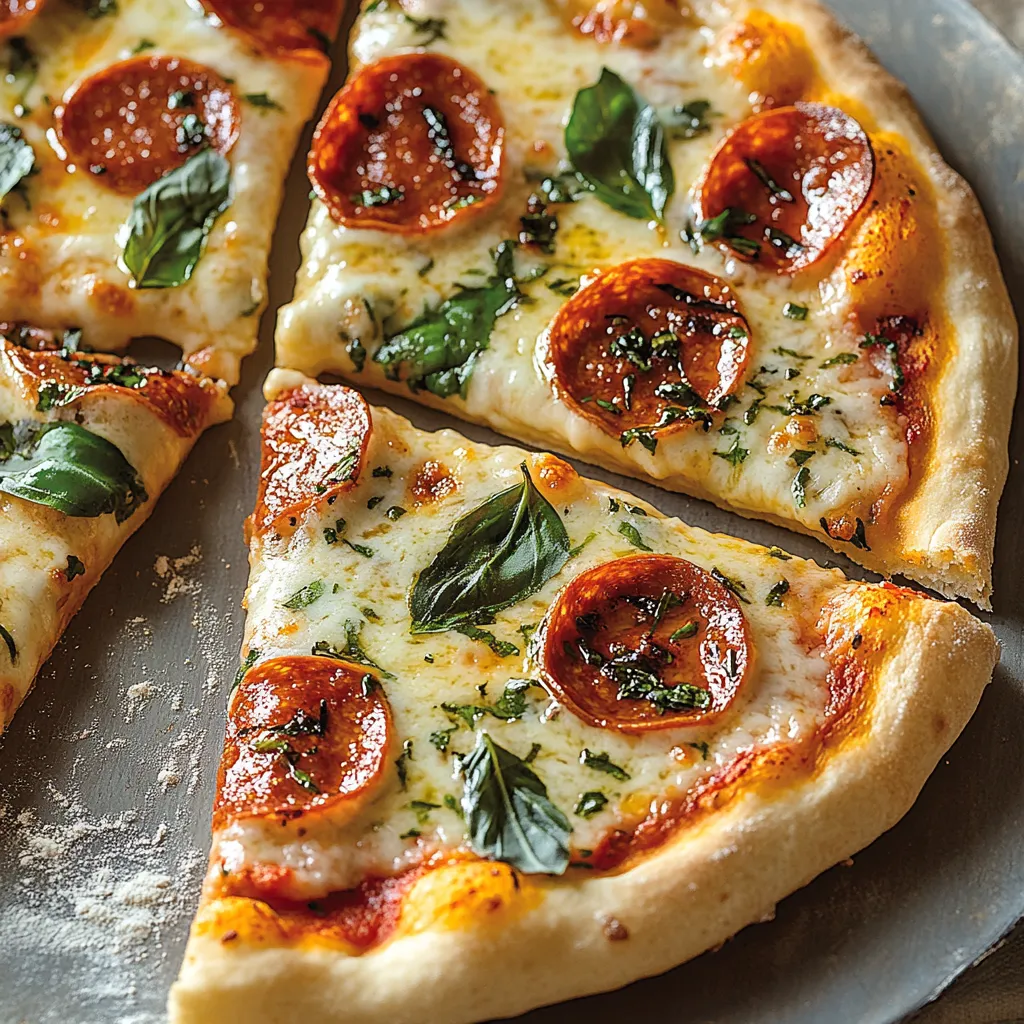 Pin it
Pin it
This handcrafted pizza base delivers the ideal balance of crunch, chew, and bubbles that'll make you forget about your local pizza place. The extended rising time builds complex taste profiles and perfect texture, becoming the cornerstone for truly outstanding homemade pies that'll wow your guests.
I stumbled on this dough method after countless disappointing homemade attempts. The first time we tried this slow rise approach, my whole family was shocked we'd made it ourselves. It's now our end-of-week tradition, and takeout pizza hasn't entered our house in forever.
Ingredients
- Bread flour: Offers extra protein for better structure and that perfect chewy bite
- Water: Should be neither hot nor cold to wake up the yeast slowly for the best rise
- Fine sea salt: Boosts taste and makes the gluten network stronger
- Instant yeast: Just a tiny bit creates a slow, steady rise without tasting too yeasty
- Olive oil: Brings a lovely richness and helps the crust turn beautifully golden
Step-by-Step Instructions
- Mix the Dough:
- Stir bread flour, salt, and instant yeast together in a big bowl until they're well mixed. Pour in room temp water and stir with your hands or a wooden spoon until you can't see any dry flour anymore. Don't worry that it looks rough and uneven right now. Let everything sit for half an hour so the flour can soak up the water and gluten starts forming without any kneading.
- Knead and Ferment:
- Pour olive oil over the top and start kneading right there in the bowl. Fold the dough over itself again and again for about 5 minutes until it looks smoother and stretches better. It should feel a bit sticky but not glue itself to your fingers. Cover your bowl with plastic or a damp cloth and let it sit at room temp for 12 to 24 hours. This long wait is when amazing flavors grow and the dough structure gets way better.
- Divide and Shape:
- Dump your risen dough onto a lightly floured counter. You'll notice it's grown two or three times bigger with lots of bubbles throughout. With flour on your hands, cut the dough into 2 to 4 equal chunks depending on how big you want your pizzas. Gently form each piece into a ball by tucking edges underneath while turning it in your hands. Put these balls on a floured tray with gaps between them and cover with a towel. Wait another hour so the dough can relax.
- Stretch and Bake:
- Put a pizza stone or steel in your oven and heat to 500°F for at least 45 minutes. Take one dough ball and push outward from the middle using your fingertips, keeping the edge a bit thicker for a nice crust. Pick up the partially flattened dough and hang it on your knuckles, letting its weight naturally stretch it to about 10 to 12 inches across. Place on a floured peel or parchment, add whatever toppings you like, and slide onto the hot stone. Bake for 7 to 10 minutes until the edges turn golden and the toppings get bubbly.
 Pin it
Pin it
The long rising time is truly what makes this special. I once tried to rush this recipe when friends showed up without warning, and though it wasn't bad, it didn't have the rich flavor and amazing texture that makes this dough stand out. My kid now calls our properly fermented version the weekend pizza and asks for it specifically.
Troubleshooting Common Issues
Dealing with sticky dough can be tricky, but don't dump in loads of extra flour. Just put a little oil on your hands when working with very tacky dough. The higher water content is what gives you those gorgeous air pockets. If your dough seems impossible to handle after rising, use a bench scraper to move it around and be gentle instead of rough when shaping it.
Temperature Considerations
How warm or cool your kitchen is really matters for pizza dough. The sweet spot for the first rise is between 65°F and 75°F. Cooler rooms slow down the process and build better flavors but take longer. Warmer spots speed everything up but might not develop such complex taste notes.
Creative Variations
You can make awesome focaccia by pressing the dough into an oiled baking sheet after it rises. Poke the surface all over with your fingers, drizzle some olive oil on top, sprinkle with chunky salt and herbs, then bake until golden. You'll get the same wonderful flavor in a completely different form.
 Pin it
Pin it
This crafted dough brings mind-blowing pizza right to your kitchen with every single bite.
Frequently Asked Questions
- → Can I keep the dough in the fridge instead of leaving it out?
Definitely! After you mix everything, pop it in the fridge for up to 3 days. This cold rest actually makes it taste even better and lets you be more flexible with timing. Just remember to let it sit out for 1-2 hours before you shape it.
- → Why does the dough need to rest so long?
The long rest lets natural enzymes break down starches, which creates deeper flavors and makes the dough easier to digest. It's also what creates that amazing texture with all those air bubbles that make homemade pizza so special.
- → Can I freeze this dough for later?
You bet! After the first rise, cut it into portions, wrap each one tightly in plastic, and stick them in the freezer for up to 3 months. When you're ready, thaw overnight in your fridge, then let it warm up on the counter for 1-2 hours before using.
- → What's the big deal between bread flour and 00 flour?
Bread flour has more protein (12-14%), which gives you a chewier base with good structure. The Italian 00 flour is ground finer with a bit less protein (11-12%), making a softer, more delicate crust that's what you'd find in traditional Neapolitan pizzas.
- → Why don't we use more yeast in this recipe?
Using just a tiny bit of yeast means the dough rises slowly, and that's what builds amazing flavor and texture. Too much yeast would make it rise too fast, missing out on all that great enzyme action that creates complex flavors during the long rest.
- → Can I make this without buying a pizza stone?
For sure! While a stone really helps get that awesome crust by holding heat like a pro oven, you can flip over a baking sheet, use a cast iron skillet, or try a pizza steel instead. Whatever you choose, make sure to heat it up for at least 45 minutes before you start baking.
